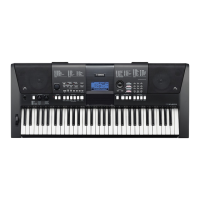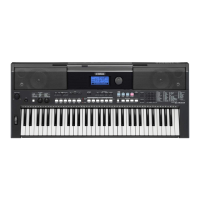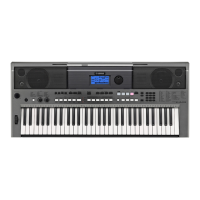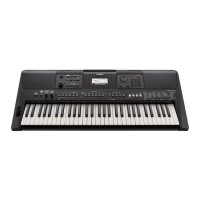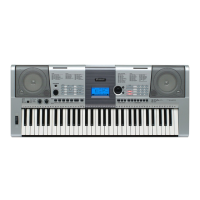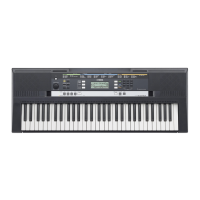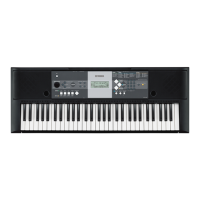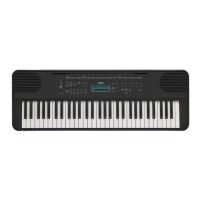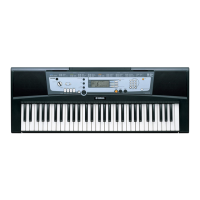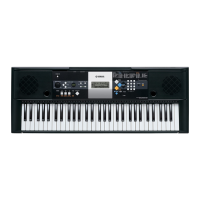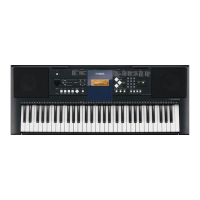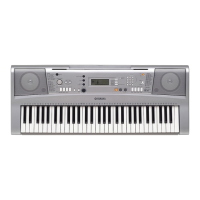Do you have a question about the Yamaha PSR-E413 and is the answer not in the manual?
Describes battery types, safety precautions, and proper disposal methods.
Covers warnings about cords, stands, and potential hearing damage from loud volumes.
FCC compliance statement and guidelines for mitigating radio frequency interference.
Wiring instructions for the UK mains plug, matching wire colors to terminals.
Statement confirming the device complies with FCC Rules Part 15.
Covers electrical shock, fire, water hazards, and opening the instrument.
Covers physical injury, battery handling, and environmental exposure.
Specific cautions for handling the instrument, including inserting objects or applying force.
Cautions for connecting components and cleaning the instrument.
Legal notice regarding copyrighted musical data and unauthorized use.
Explanations of logos like GM System Level 1, XGlite, USB, Touch Response, and Style File.
Instructions for attaching the music rest to the instrument.
Using knobs to adjust sound characteristics like distortion and filter.
Automatic generation of arpeggios (broken chords) by playing notes.
Technology that helps users play songs accurately, even with mistakes.
Changing instrument sounds and using auto-accompaniment styles.
Guidelines for using the AC adaptor and batteries for power.
Steps for connecting the AC adaptor and inserting batteries.
Connecting headphones, footswitch, and computer via USB.
Steps for turning the instrument on and off using the standby switch.
Overview of buttons, knobs, and displays on the front panel.
Overview of jacks and ports located on the rear panel.
How the arpeggio function engages with specific voices.
How to choose and set different arpeggio patterns.
How to play notes on the keyboard to trigger arpeggio effects.
Step-by-step guide to creating a pop tune using styles and arpeggios.
Combining styles with arpeggios and managing left/right hand parts.
Mapping filter, effect, EG, style filter, and tempo effects to the control knobs.
Shaping sound using filter cutoff frequency and resonance.
Adding ambience with reverb and thickness with chorus effects.
Adjusting attack, release, and sustain for sound variations.
Applying filter and tempo variations to accompaniment styles.
Step-by-step guide for selecting a voice and adjusting knob effects.
Practical examples and suggestions for using various knob effects.
Overview of the technology that aids in playing songs accurately.
How to choose and select songs for practice sessions.
Playing the keyboard along with the song's accompaniment.
Advanced tips and methods for improved performance with the assistant.
A tutorial for playing the Nocturne song using the Easy Way to Play Piano feature.
How to adjust the tempo of a song for practice or preference.
How to choose and play the primary instrument voice.
Layering two different voices for a richer sound.
Using different voices for the left and right sections of the keyboard.
One-button access to the Grand Piano voice across the entire keyboard.
Exploring and playing drum kits and various sound effects.
How to choose and start playing different auto-accompaniment styles.
Adding bass and chord accompaniment to style rhythms.
How the auto-accompaniment region functions for chord input.
Combining left-hand chords with right-hand melodies for accompaniment.
Using chord progressions to create more interesting accompaniments.
Example: 3-chord boogie-woogie progression.
Example: Bossa nova with jazz-style chords.
Easy and Standard chord playing methods for auto-accompaniment.
How to choose and listen to the instrument's built-in songs.
Functions for fast forward, rewind, and pausing song playback.
How to use the DEMO/PC button for sequential song playback.
List of built-in songs with suggested applications for learning and features.
Differentiating between preset, user, and external song file types.
Introduction to the education suite and its practice methods (Lesson 1, 2, 3).
How to choose and select songs for practice sessions.
Choosing left-hand, right-hand, or both-hands practice modes.
How to begin the first lesson mode: learning correct notes.
Exiting a lesson mode at any time.
How the instrument evaluates performance after a lesson.
Learning notes with correct timing and adaptive tempo adjustment.
Practicing a song with the melody part removed (minus one).
Using the feature to practice difficult sections repeatedly.
Choosing a database entry for automatic panel settings.
Demonstrating the Easy Song Arranger feature with a demo song.
How to change a song's arrangement style.
Hearing how different styles affect the sound of a song.
Selecting a new voice for the song's melody part.
Understanding the tracks and data types that can be recorded.
Function to mute or unmute recorded tracks during playback.
Steps to start the recording process.
Choosing which tracks to record and confirming the selection.
How recording begins when playing the keyboard and how to stop it.
How to play back recorded user songs similar to internal songs.
Information on limitations for data recording, such as split voice.
Procedure to delete an entire recorded user song.
Procedure to delete a specific track from a recorded user song.
Details on settings that are automatically backed up and maintained.
Restoring the instrument to its initial factory default settings.
Core operations: select function, select item, start function.
How to control the master volume of the instrument.
Using the dial and number buttons for selecting items and adjusting values.
Explanations of various indicators and elements shown on the LCD display.
Adding harmony notes to the main voice based on played chords.
How to select and use different harmony types.
Applying reverb effects to create ambience.
Controlling the amount of reverb applied to each voice.
Applying chorus effects for a thicker, layered sound.
Controlling the amount of chorus applied to each voice.
Using the built-in metronome for practice.
Setting the metronome's tempo and beats per measure.
Setting the volume level for the metronome.
Using the TEMPO/TAP button for a count-in at any tempo.
Adjusting keyboard sensitivity to playing dynamics.
Using the wheel to modulate pitch for expressive playing.
Shifting the instrument's overall pitch and tuning.
Adjusting arpeggio volume based on keyboard velocity.
Automatically selects a suitable voice when a style or song is chosen.
Adjusting the volume level of the harmony effect.
Selecting equalizer settings for optimal sound output.
Using Intro, Main (A/B), Fill-in, and Ending sections to vary arrangements.
Using Main/Auto Fill, Intro/Ending, Synchro Stop buttons for style control.
Setting the volume level for accompaniment styles.
Defining the keyboard split point for different voice assignments.
Playing chords without rhythm accompaniment active.
Loading custom style files into style number 166.
Fundamentals of chords, including triads, inversions, and intervals.
How to interpret chord names for root, type, and tensions.
Examples of recognized chord types like major, minor, and seventh chords.
List of standard chords the instrument recognizes, with voicing and display info.
Learning how to play chords using the instrument's built-in chord dictionary.
Setting the volume level for song playback.
Repeating a specific section (A to B) of a song.
Isolating or silencing specific tracks within a song.
Replacing the default melody voice of a song.
Storing favorite instrument configurations for quick recall.
Loading previously saved panel settings.
Overview of the types of settings that can be saved to Registration Memory.
Setting the auto-power-off timer to conserve energy.
How to navigate and adjust the instrument's detailed functions.
Details on Style, Song, Transpose, Tuning, and Voice functions.
Details on Effect, Harmony, Arpeggio, MIDI, and Lesson functions.
Explanation of Musical Instrument Digital Interface (MIDI) and its uses.
How digital instruments generate sound based on keyboard input.
Steps for establishing a USB connection between the instrument and a computer.
Safety guidelines and precautions to avoid data corruption or freezing.
Moving performance data between the instrument and a computer.
Configuration of MIDI transmission settings like Local On/Off and Keyboard Out.
Optimizing MIDI settings for PC communication.
Using the instrument as a remote controller for computer applications.
Sending panel setup data to a computer before recording performance data.
Overview of transferring songs, styles, and database files.
Details on the Standard MIDI File (SMF) format.
Using the Musicsoft Downloader software to transfer songs from the CD-ROM.
Moving backup data, including user songs, from the instrument to a computer.
Setting up transferred songs for right-hand and left-hand lesson parts.
General legal and usage notices regarding the software and manual.
Key information and warnings about using the CD-ROM.
Information on CD-ROM contents and required operating systems.
Step-by-step guide for installing and using the CD-ROM contents.
Listing the software (drivers, applications) and data files on the CD-ROM.
Hardware and software requirements for installing CD-ROM applications.
General instructions for installing software from the CD-ROM.
Specific steps for installing the necessary USB-MIDI driver.
Detailed steps for installing the USB-MIDI driver on Windows 2000.
Detailed steps for installing the USB-MIDI driver on Windows XP.
Detailed steps for installing the USB-MIDI driver on Windows Vista.
Installing key applications from the CD-ROM.
Common problems and solutions related to software installation.
Resolving issues with no sound, poor quality, or cutting off.
Addressing problems with styles and songs not playing or sounding correctly.
Troubleshooting voices, ACMP, harmony, and polyphony related problems.
Musical score for the Hallelujah Chorus song.
Musical score for Ave Maria with performance assistant technology notes.
Musical score for Nocturne op.9-2 with performance assistant technology notes.
Details on the instrument's 32-note maximum polyphony limit.
Listing and describing available panel voices by category.
Listing XGlite and optional XGlite voices.
Details on drum sounds assigned to keyboard keys and their MIDI note numbers.
Descriptions of various harmony effect types.
Descriptions of various reverb effect types.
Descriptions of various chorus effect types.
Mapping MIDI values to effect types for reverb and chorus.
Details on keys, touch response, and display.
Specifications for setup options and panel controls.
Details on voices, polyphony, dual/split, and styles.
Specifications for functions, effects, and MIDI.
Details on songs, recording, and lessons.
Auxiliary jacks, amplifier, speakers, and power.
Supplied/optional accessories and physical dimensions.
Details on warranty coverage duration and user obligations for service.
Conditions and circumstances under which the warranty is void.
Describes battery types, safety precautions, and proper disposal methods.
Covers warnings about cords, stands, and potential hearing damage from loud volumes.
FCC compliance statement and guidelines for mitigating radio frequency interference.
Wiring instructions for the UK mains plug, matching wire colors to terminals.
Statement confirming the device complies with FCC Rules Part 15.
Covers electrical shock, fire, water hazards, and opening the instrument.
Covers physical injury, battery handling, and environmental exposure.
Specific cautions for handling the instrument, including inserting objects or applying force.
Cautions for connecting components and cleaning the instrument.
Legal notice regarding copyrighted musical data and unauthorized use.
Explanations of logos like GM System Level 1, XGlite, USB, Touch Response, and Style File.
Instructions for attaching the music rest to the instrument.
Using knobs to adjust sound characteristics like distortion and filter.
Automatic generation of arpeggios (broken chords) by playing notes.
Technology that helps users play songs accurately, even with mistakes.
Changing instrument sounds and using auto-accompaniment styles.
Guidelines for using the AC adaptor and batteries for power.
Steps for connecting the AC adaptor and inserting batteries.
Connecting headphones, footswitch, and computer via USB.
Steps for turning the instrument on and off using the standby switch.
Overview of buttons, knobs, and displays on the front panel.
Overview of jacks and ports located on the rear panel.
How the arpeggio function engages with specific voices.
How to choose and set different arpeggio patterns.
How to play notes on the keyboard to trigger arpeggio effects.
Step-by-step guide to creating a pop tune using styles and arpeggios.
Combining styles with arpeggios and managing left/right hand parts.
Mapping filter, effect, EG, style filter, and tempo effects to the control knobs.
Shaping sound using filter cutoff frequency and resonance.
Adding ambience with reverb and thickness with chorus effects.
Adjusting attack, release, and sustain for sound variations.
Applying filter and tempo variations to accompaniment styles.
Step-by-step guide for selecting a voice and adjusting knob effects.
Practical examples and suggestions for using various knob effects.
Overview of the technology that aids in playing songs accurately.
How to choose and select songs for practice sessions.
Playing the keyboard along with the song's accompaniment.
Advanced tips and methods for improved performance with the assistant.
A tutorial for playing the Nocturne song using the Easy Way to Play Piano feature.
How to adjust the tempo of a song for practice or preference.
How to choose and play the primary instrument voice.
Layering two different voices for a richer sound.
Using different voices for the left and right sections of the keyboard.
One-button access to the Grand Piano voice across the entire keyboard.
Exploring and playing drum kits and various sound effects.
How to choose and start playing different auto-accompaniment styles.
Adding bass and chord accompaniment to style rhythms.
How the auto-accompaniment region functions for chord input.
Combining left-hand chords with right-hand melodies for accompaniment.
Using chord progressions to create more interesting accompaniments.
Example: 3-chord boogie-woogie progression.
Example: Bossa nova with jazz-style chords.
Easy and Standard chord playing methods for auto-accompaniment.
How to choose and listen to the instrument's built-in songs.
Functions for fast forward, rewind, and pausing song playback.
How to use the DEMO/PC button for sequential song playback.
List of built-in songs with suggested applications for learning and features.
Differentiating between preset, user, and external song file types.
Introduction to the education suite and its practice methods (Lesson 1, 2, 3).
How to choose and select songs for practice sessions.
Choosing left-hand, right-hand, or both-hands practice modes.
How to begin the first lesson mode: learning correct notes.
Exiting a lesson mode at any time.
How the instrument evaluates performance after a lesson.
Learning notes with correct timing and adaptive tempo adjustment.
Practicing a song with the melody part removed (minus one).
Using the feature to practice difficult sections repeatedly.
Choosing a database entry for automatic panel settings.
Demonstrating the Easy Song Arranger feature with a demo song.
How to change a song's arrangement style.
Hearing how different styles affect the sound of a song.
Selecting a new voice for the song's melody part.
Understanding the tracks and data types that can be recorded.
Function to mute or unmute recorded tracks during playback.
Steps to start the recording process.
Choosing which tracks to record and confirming the selection.
How recording begins when playing the keyboard and how to stop it.
How to play back recorded user songs similar to internal songs.
Information on limitations for data recording, such as split voice.
Procedure to delete an entire recorded user song.
Procedure to delete a specific track from a recorded user song.
Details on settings that are automatically backed up and maintained.
Restoring the instrument to its initial factory default settings.
Core operations: select function, select item, start function.
How to control the master volume of the instrument.
Using the dial and number buttons for selecting items and adjusting values.
Explanations of various indicators and elements shown on the LCD display.
Adding harmony notes to the main voice based on played chords.
How to select and use different harmony types.
Applying reverb effects to create ambience.
Controlling the amount of reverb applied to each voice.
Applying chorus effects for a thicker, layered sound.
Controlling the amount of chorus applied to each voice.
Using the built-in metronome for practice.
Setting the metronome's tempo and beats per measure.
Setting the volume level for the metronome.
Using the TEMPO/TAP button for a count-in at any tempo.
Adjusting keyboard sensitivity to playing dynamics.
Using the wheel to modulate pitch for expressive playing.
Shifting the instrument's overall pitch and tuning.
Adjusting arpeggio volume based on keyboard velocity.
Automatically selects a suitable voice when a style or song is chosen.
Adjusting the volume level of the harmony effect.
Selecting equalizer settings for optimal sound output.
Using Intro, Main (A/B), Fill-in, and Ending sections to vary arrangements.
Using Main/Auto Fill, Intro/Ending, Synchro Stop buttons for style control.
Setting the volume level for accompaniment styles.
Defining the keyboard split point for different voice assignments.
Playing chords without rhythm accompaniment active.
Loading custom style files into style number 166.
Fundamentals of chords, including triads, inversions, and intervals.
How to interpret chord names for root, type, and tensions.
Examples of recognized chord types like major, minor, and seventh chords.
List of standard chords the instrument recognizes, with voicing and display info.
Learning how to play chords using the instrument's built-in chord dictionary.
Setting the volume level for song playback.
Repeating a specific section (A to B) of a song.
Isolating or silencing specific tracks within a song.
Replacing the default melody voice of a song.
Storing favorite instrument configurations for quick recall.
Loading previously saved panel settings.
Overview of the types of settings that can be saved to Registration Memory.
Setting the auto-power-off timer to conserve energy.
How to navigate and adjust the instrument's detailed functions.
Details on Style, Song, Transpose, Tuning, and Voice functions.
Details on Effect, Harmony, Arpeggio, MIDI, and Lesson functions.
Explanation of Musical Instrument Digital Interface (MIDI) and its uses.
How digital instruments generate sound based on keyboard input.
Steps for establishing a USB connection between the instrument and a computer.
Safety guidelines and precautions to avoid data corruption or freezing.
Moving performance data between the instrument and a computer.
Configuration of MIDI transmission settings like Local On/Off and Keyboard Out.
Optimizing MIDI settings for PC communication.
Using the instrument as a remote controller for computer applications.
Sending panel setup data to a computer before recording performance data.
Overview of transferring songs, styles, and database files.
Details on the Standard MIDI File (SMF) format.
Using the Musicsoft Downloader software to transfer songs from the CD-ROM.
Moving backup data, including user songs, from the instrument to a computer.
Setting up transferred songs for right-hand and left-hand lesson parts.
General legal and usage notices regarding the software and manual.
Key information and warnings about using the CD-ROM.
Information on CD-ROM contents and required operating systems.
Step-by-step guide for installing and using the CD-ROM contents.
Listing the software (drivers, applications) and data files on the CD-ROM.
Hardware and software requirements for installing CD-ROM applications.
General instructions for installing software from the CD-ROM.
Specific steps for installing the necessary USB-MIDI driver.
Detailed steps for installing the USB-MIDI driver on Windows 2000.
Detailed steps for installing the USB-MIDI driver on Windows XP.
Detailed steps for installing the USB-MIDI driver on Windows Vista.
Installing key applications from the CD-ROM.
Common problems and solutions related to software installation.
Resolving issues with no sound, poor quality, or cutting off.
Addressing problems with styles and songs not playing or sounding correctly.
Troubleshooting voices, ACMP, harmony, and polyphony related problems.
Musical score for the Hallelujah Chorus song.
Musical score for Ave Maria with performance assistant technology notes.
Musical score for Nocturne op.9-2 with performance assistant technology notes.
Details on the instrument's 32-note maximum polyphony limit.
Listing and describing available panel voices by category.
Listing XGlite and optional XGlite voices.
Details on drum sounds assigned to keyboard keys and their MIDI note numbers.
Descriptions of various harmony effect types.
Descriptions of various reverb effect types.
Descriptions of various chorus effect types.
Mapping MIDI values to effect types for reverb and chorus.
Details on keys, touch response, and display.
Specifications for setup options and panel controls.
Details on voices, polyphony, dual/split, and styles.
Specifications for functions, effects, and MIDI.
Details on songs, recording, and lessons.
Auxiliary jacks, amplifier, speakers, and power.
Supplied/optional accessories and physical dimensions.
Details on warranty coverage duration and user obligations for service.
Conditions and circumstances under which the warranty is void.
| Number of Keys | 61 |
|---|---|
| Touch Response | Yes |
| Amplification | 2.5W + 2.5W |
| Polyphony | 32 |
| Effects | Reverb, Chorus |
| Songs | 30 preset, 5 user |
| Display | LCD (backlit) |
| Connectivity | USB to Host |
| Power Supply | batteries |
| Speakers | 2 x 12 cm |
| Dimensions | 946 x 405 x 136 mm |
